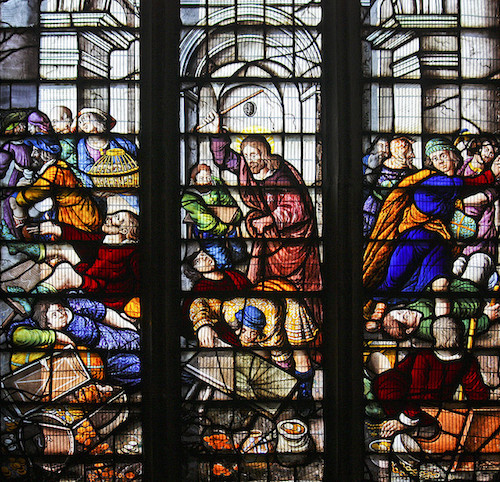We run our website the way we wished the whole internet worked: we provide high quality original content with no ads. We are funded solely by your direct support. Please consider supporting this project.

The Cleansing of the Temple and Non-Violence
Jesus’ cleansing of the Temple is the most commonly cited example of those who allege that he did not absolutize loving enemies or refraining from violence. I submit that this episode implies nothing of the sort. First, it is important that we understand that this episode was not an expression of unpremeditated anger on Jesus’ part, as some allege. Most NT scholars concur that this was a calculated, strategic act on Jesus’ part, and it contained deep symbolic significance. More specifically, this episode appears to be a classic example of a prophetic symbolic action.
There is, however, some disagreement over what exactly Jesus was symbolizing. For example, many argue that Jesus was revealing himself to be the long-awaited messiah who was widely expected to cleanse and/or restore the Temple. Others argue that Jesus was symbolically revealing Yahweh’s displeasure with the corrupt religious establishment and issuing a prophetic warning that the Temple would soon be destroyed, a point that John makes explicit (Jn 2: 19-22). While interpretations differ, however, they all presuppose that the Temple cleansing was anything but a spontaneous tantrum on the part of Jesus.
Second, there is simply no indication in any of the Gospels that Jesus resorted to violence when he cleansed the Temple. Yes, the texts suggest that Jesus was angry, and yes, John tells us that Jesus made a whip (Jn 2:15). But there is no suggestion that he used it to strike any animal or person. To the contrary, throughout history cracking a whip has been a commonly used means of controlling the movement of animals, and John explicitly reports that this is what Jesus used it for. He used the whip to create an animal stampede of “both sheep and cattle” out of the “temple courts” (Jn 2:15). Not only this, but had Jesus actually whipped any of the court officials, it is hard to imagine how he could have avoided being arrested on the spot. It is also hard to imagine how he could have avoided the charge of hypocrisy, for such behavior would have flown in the face of his previously mentioned public teachings about refraining from violence.
There is therefore nothing about Jesus’ cleansing of the temple that runs counter to my claim that the non-violent, enemy-embracing, self-sacrificial love that was supremely revealed on the cross is the thematic center of Jesus’ identity and mission. To the contrary, Jesus engaged in a kind of “street theater” out of love for his “Father’s house” as well as for the poor who were being oppressed by the corrupt leaders who ran the Temple’s “buying and selling” system. And, as the Gospels make clear, he confronted these leaders in this aggressive manner as a way of forcing their hand, and thus as a steppingstone to his crucifixion. Far from illustrating Jesus acting in an unloving, let alone violent way, I submit that this entire episode reflects Jesus’ self-sacrificial love.
Moreover, John explicitly makes the cross the thematic center of this episode, for he records that Jesus brings this episode to a close by drawing a connection between the newly cleansed temple, which Jesus prophesied would soon be permanently destroyed, and his own body, which would rise again three days after being destroyed (Jn 2:19-22). Read in context, NT scholar Richard Hays notes, John is declaring “that Jesus’ body is now the place where God dwells, the place where atonement for sin occurs, the place where the division between God and humanity is overcome.” Hence, far from counting against the thematic centrality of the cross, the Temple cleansing illustrates this centrality.
Photo credit: Lawrence OP via VisualHunt.com / CC BY-NC-ND
Category: General
Tags: Cross, Love, Non-Violence
Topics: Enemy-Loving Non-Violence
Related Reading

Cruciform Theology in Four Steps
The culmination of the biblical narrative of the cross reframes everything about who God is, what it means to have faith in God, and how we read the Bible! The entire Old Testament leading up to the crucified Christ must be interpreted with a view toward discerning how it anticipates and points toward this definitive…

A Non-Violent Creation
A biblical teaching that we often overlook regarding the centrality of non-violence concerns God’s original vision of creation. We have grown so accustomed to the violence we experience as a part of nature that we don’t even question whether it is supposed to be the way it is. However when we see God’s vision for…

Should Christians really only use non-violent resistance to things like war/genocide?
Question: Greg Boyd describes himself as a pacifist. I am curious to know what he thinks about wars or any other situation where genocide is happening. When such evil things are being done by force and violence, how should Christians, and other moral, loving people for that matter, respond? Are we really to use only non-violent…

The Principle of Non-Violence
Several years ago, Woodland Hills Church hosted a Q&A with Greg Boyd and Paul Eddy to answer questions that arose from their exploration of Anabaptism. In this short clip, they address the Anabaptist principle of non-violence, and point out that this principle goes far beyond refraining from external violence. The call to non-violence is grounded in our…

A Brief Theology of Salvation
In the NT, one of the most frequent and fundamental images used to depict our salvation is “redemption.” The root of this term lytron means a “ransom” or “price of release,” and the term itself (apolytrosis) was used as a kind of technical term for the purchase of a slave. If we apply this to…

Podcast: If Violence is Wrong, Why Passively Allow Others to Use It?
Greg discusses dealing with the violence of loved ones. http://traffic.libsyn.com/askgregboyd/Episode_0166_.mp3
